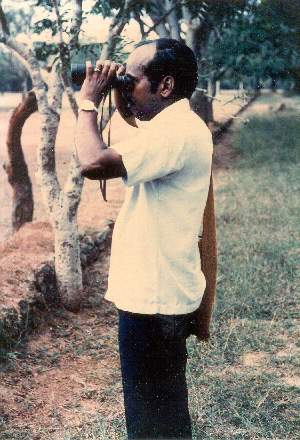
Home | Biodata | Biography | Photo Gallery | Publications | Tributes
Nature Study

 |
Home | Biodata | Biography | Photo Gallery | Publications | Tributes Nature Study |
 |
The National Park for petrified wood near Tiruvakkarai village is a fascinating place to visit. The village is situated in picturesque surroundings on the northern bank of a small river called Sankaraabarni. The river is safe for visitors since there is not much water in it but mainly sand. The village derives its name Tiruvakkarai from two words, Tiru and Vakkarai. Vakkarai was its original name and the word Tiru denotes the fact that it was once an important place of pilgrimage. There is, in fact, an ancient temple complex in the village with a lion-pillared mandapa and many inscriptions. Some of the inscriptions go back to the time of Rajaraja Chola, the famous emperor of the eleventh century A.D. The pilgrim centre has found a place in the Devaram hymns in which Sambandar refers to it as Vakkarai as well as Thirvakkarai.
The village is about 150 kms from Madras and there is now, good motorable road to the fossil site. The route goes through Tindivanam and Mayilam towards Pondicherry and takes a turn to the south at 20 kms. from Tindivanam.
The park area has been fenced off and there is a watchman posted near the main enclosure which has a spreading banyan tree and cement benches. There are also prehistoric stone-circles of the iron-age period within the enclosure.
The smaller enclosure nearer the little river has something spectacular to offer. Huge stone logs, resembling logs of wood are fully exposed from the ground and when the visitor gets closer he can see that the logs are really fossils -- trees turned into stone. In other enclosures one can see petrified trunks of trees as long as 30 metres with their ends exposed to view due to erosion. If the main trunk is 30 metres long, the living tree would have been two or three times taller. We do not have any such tall variety of trees that grows in the area today.
Paleobotanists, who specialize in the study of plant fossils, have devised a method of finding out the family to which a given plant fossil belongs. A small piece of fossil wood is chipped off and thin sections are made out of the piece. The sections are viewed under the microscope and the study will show characteristic features of the wood. The scientists compare these with the microscopic features of living trees and assign the fossil trees to different families.
It turns out that most of the fossil trees found at the Tiruvakkarai site belong to a family of coniferous trees. In south India we find tall trees of the coniferous family high up in the cold climate of the hills and not on the hot plains. Pieces of petrified wood collected from a larger area up to Pondicherry have yielded forms that belong to the palm family as well as recent forms of flowering trees.
The huge trees must have traveled some distance since there are no branches and the logs are smooth. Finding a piece with a bark is rather rare and the author has collected such pieces from outside the protected area. The whole region is strewn with small pieces of fossil wood which are thrown away by farmers from agricultural land. They are called vakaraangal by the local people. Visitors are allowed to collect small pieces from private land.
As one leaves the National Park there remains the gnawing question as to how the trees got transformed into stone. Well, the trees from the then existing hills in the area would have moved along with rushing streams arid got deposited into sand in the sea which once covered the area. The tree was completely protected from bacterial action, and over a period of 10 to 20 million years the tree would have been replaced cell by cell by chemical action and got transformed into stone.
How do people arrive at the approximate period when the tree was alive ? The time is fixed by geologists using the fact that the trees are found embedded in a stone called Cuddalore Sandstone. This sedimentary rock belongs to the geological period called Upper Tertiary which goes back to 25 million years.
Fossils which are a little older than this are found in the Ariyalur area in Tiruchi district and they belong to a period called Upper Cretaceous . Fossils of a still earlier period are found near Sriperumbudur near Madras where petrified wood as leaf-impressions are found in another sedimentary rock called shale or white clay.
There are no curio shops at Tiruvakkarai. However children will be delighted by the pebbles and fossil pieces they pick up. Older folks who like some thing more solid may go in for the stone sculptures and grinding stones made in the area from black granite.